
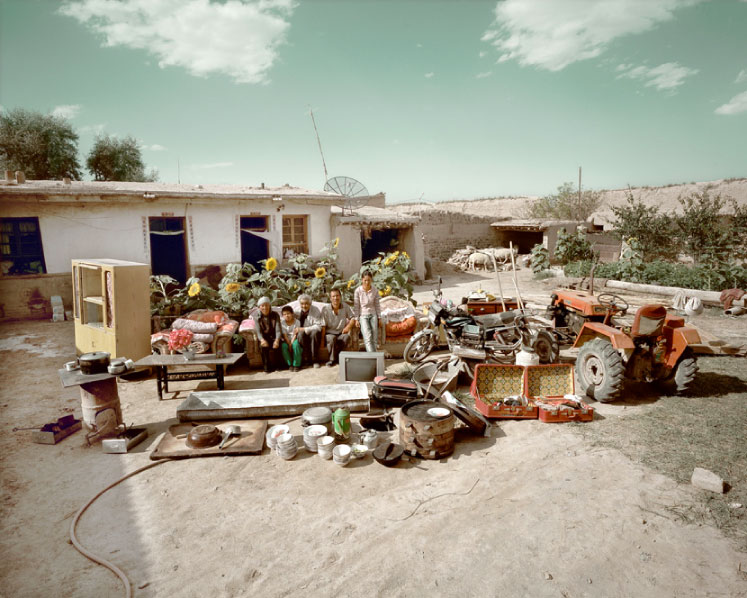
All photography by Huang Quingjun and Ma Hongjie (Click images to enlarge)
 Family Stuff
Family Stuff, a photojournalism project by Beijing-based photographers
Huang Quingjun and
Ma Hongjie, has been circulating among blogs for a couple of years now. We came across it recently and wanted to share the work. Huang and Ma juxtapose the results of China’s economic progress with its enduring poverty – often in the same household – by documenting families and their belongings arranged outside of their homes.
The photographers capture Chinese families from various regions and ethnicities. Ma in particular focuses on the country’s rural majority, rather than the urban population more frequently displayed by the media. While to first-world eyes the number of possessions appears scant, their owners are obviously proud of what they’ve gained in recent times. Occasionally, too, other faces are more troubled, as seen in the expressions of a family in the resettlement program in Beijing, waiting to move to a new home so their old residence can be demolished.
Huang and Ma work completely independently of one another: Huang covers the Northern half of China while Ma documents the South. The shoots can take months to finish. Although families are compensated for their trouble, the task of explaining the project and convincing families to so nakedly display themselves and their possession often proves difficult. Six years in the making, this epic project will result next year in fifty photos and a book.
(more…)

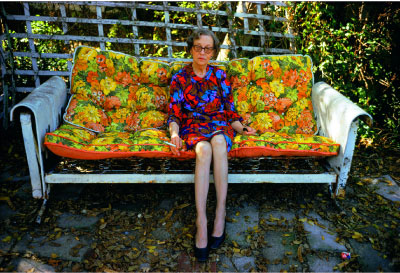
William Eggleston, Jackson, Mississippi, 1969-70 All photography courtesy of Hatje Cantz Publishers (Click images to Enlarge)


Color photography may have been invented as early as 1907, but the artistic viability of the medium was questioned even as recently as the 1980s. Henri Cartier-Bresson, who is currently the subject of
a retrospective at MoMA, was a particularly notable opponent.
Starburst: Color Photography in America 1970-1980, released this spring by Hatje Cantz publishers, explores the work and ramifications of the artists whose breakthrough images opened the floodgates for color photography’s later practitioners. Beginning with William Eggleston’s watershed show at MoMA in 1976, the book takes readers through the early work and critiques of contemporaries Stephen Shore, Helen Levitt, Joel Meyerowitz, William Christenberry, Jan Groover, Barbara Kasten, Richard Misrach, Joel Sternfeld, Eve Sonneman, and many more. Accompanied by contemporary critical essays as well as many original reviews, this survey provides a snapshot of a powerful and surprisingly recent paradigm shift in the course of modern photography.
(more…)

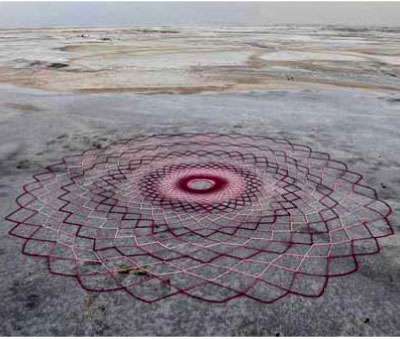
Atefeh Kash and Tarah Goodarzy's crocheted fiber installation in Iran (photography by Sharnaz Zarkesh)

Fiber, one of the most ancient natural materials, is currently enjoying somewhat of a renaissance. Used for craftwork, utilitarian items, clothing, and contemporary art, fiber today serves as “a resilient and easily sourced material for many of today’s sustainable design solutions”. Re-fashioning, recycling, or reusing natural fiber is gaining in popularity, as a new wave of eco-crafting hints at the ways in which fiber is working to reconnect artists and consumers to one another as well as to our threatened natural world. A synecdoche for a more environmentally-conscious world, environmental and textile artist
Abigail Doan’s upcoming Tribeca exhibit examines new ways of considering fiber “in relation to the natural environment, our patterns of consumption, and contemporary definitions of fashioning self”.
According to Doan,
(Re)Fashioning Fiber will include “collaborative environmental fiber art from Iran; handcrafted vegetation jewelry from Bulgaria; sustainable, locally-minded fashion and drawings by Eko-Lab; no-waste textile fashion by Study NY; recycled ‘flotsam fiber’ from the streets of NYC; handmade books spinning tales about a global pilgrimage; crochet tower structures infused with sound”, and much more.
(Re)Fashioning Fiber opens tomorrow, May 20, 6:30-8:30pm at
Green Spaces NY, 394 Broadway, 5th Floor. The exhibit will be on view through August 13, 2010.
(more…)

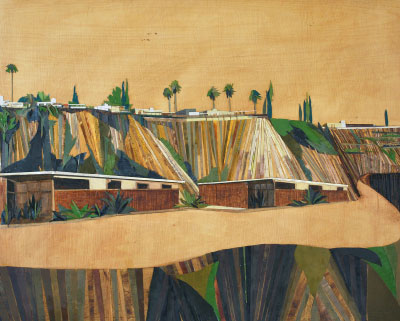
Beverly Ridge All artwork courtesy of Cheryl Molnar. (Click Images to Enlarge)

 Cheryl Molnar
Cheryl Molnar has lived in New York for most of her life. Born and bred on Long Island, the young collage artist currently lives and works in Greenpoint, Brooklyn. Fascinated by the shifts and alterations constantly happening to the urban locales in which she lives, Molnar creates intricate, powerful collages that capture tenuous moments of architectural change. We interviewed Molnar via e-mail about gentrification, her unique choice of artistic medium, and an intriguing future project on the rapidly-changing Williamsburg/Greenpoint waterfront.
You grew up on Long Island and currently live in Brooklyn. How have the places you’ve lived influenced your work, and what draws you to depict them?
I have always been sensitive to my surroundings. Growing up in a working-class neighborhood on Long Island, I spent time in a place that was engineered to provide young families with the “American Dream” — new (at the time) ranch houses, “modern” appliances, a small patch of green space and a driveway. But the structures and goods, manufactured to supply this dream, were generally poorly constructed, impersonal and generic. This “assembly line” production not only prevented neighborhoods from developing any lasting character but did not integrate itself into the natural surroundings. This disregard for nature deeply affected me and is one of the central themes in my work.
(more…)
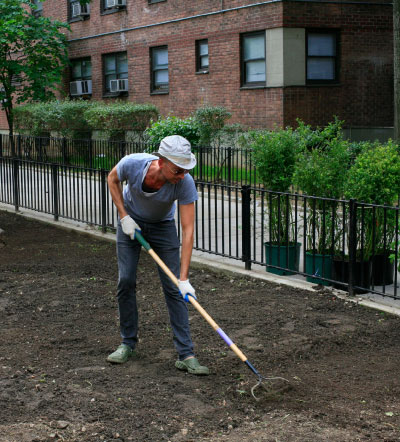
Portrait of Fritz Haeg by Oto Gillen. All images are courtesy of Distributed Art Publishers, Inc.

Formerly a fringe movement, the concept of edible gardening might now officially be called a nationwide trend (after all, even Michelle Obama is doing it). The premise? To rid our suburbs of resource-draining expanses of green lawns and replace them with sustaining — and sustainable — vegetable gardens. Since the first edition of
Edible Estates: Attack on the Front Lawn, by author and activist Fritz Haeg, was published in 2008, the edible landscaping movement has only gained followers.
Last month saw the release by Metropolis Books of the greatly expanded
second edition of Edible Estates, which documents the eight regional prototype food gardens that Haeg designed and planted in California, Kansas, Texas, Maryland, New Jersey, New York, and England. Alongside countrywide reports from individuals who have planted their own edible gardens, the book features essays by edible-landscaping pioneer Rosalind Creasy, artist and writer Lesley Stern, and bestselling author Michael Pollan. Other highlights include Haeg’s thoughts on Michelle Obama’s vegetable garden on the White House lawn and the never-before-published Declaration of the Good Food Revolution by MacArthur Fellow and urban farmer Will Allen.
As Eva Hagberg of
Architectural Record writes, this book “is not an attack on the front lawn. It is an attack on our sanctificiation of the idea of sameness.” A chimeric mash-up between how-to book, garden showcase, and landscaping manifesto, the second edition of
Edible Estates: Attack on the Front Lawn teaches and inspires readers to see their urban landscape with new eyes, and to understand the ways in which private property can become a public model for social change.
(more…)
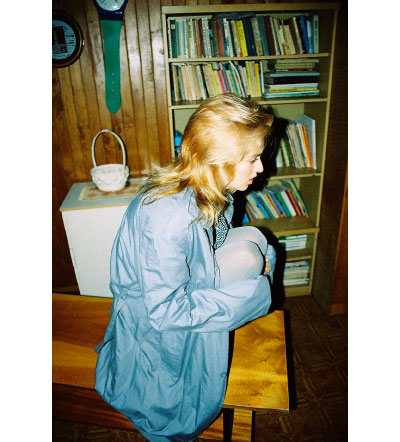
Photography by Lukasz Wierzbowski (Click Images to enlarge)

The photography of Lukasz Wierzbowski — a photographer and social psychology student currently living in Wroclaw, Poland — unsettles. His pictures feature gorgeous young women in the woods or at home or on the street; wherever they are, their figures alone occupy the frame. Draping themselves across tree branches, grassy lawns, or unkempt bedspreads, these women seem bored and frustrated with the viewer’s gaze — in almost every image, the face of the model is turned away, obscured, or simply facing the camera with eyes staunchly shut. There is something uncanny about these pictures; looking at them, the viewer feels implicated as voyeur into someone else’s private world.
Despite the fact that his work appears rich with implied meaning, Wierzbowski explains that he doesn’t have any kind of artist statement: “The only thing I can say [about my work] is that I feel strongly attached to this certain mood, feeling of in-between where not everything is the way it seems.” Indeed, Wierzbowski’s images bring to mind that old joke: “I woke up this morning and discovered that someone had stolen all my stuff and replaced it with exact replicas.” While the world in these pictures looks just as we expect it to, something in the atmosphere just doesn’t feel right.
(more…)
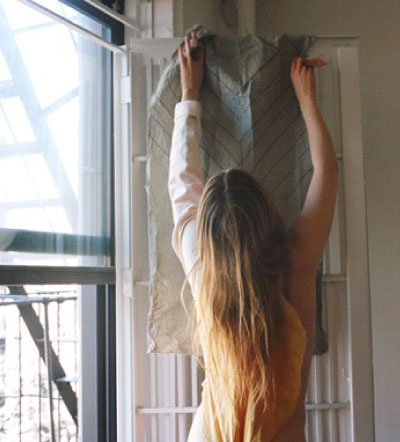
Photography by Lily Ferguson

Sustainable Exchange, a series of weekend workshops, installations and exhibits featuring artists who work within the sustainability movement will take over TODA Design Studio on West Broadway to demonstrate and explore the versatility and possibilities of sustainable consumption in the fields of art and design. Featuring performance artists, textile artists, fashion designers and musicians—plus many more—the gallery exhibition and workshops are offered free and open to the public 12-6pm daily. The range of workshops is wide: beginner finger crochet (no hooks necessary); the art of dyeing cloth with natural sources such as spices, teas, and roots; fashion illustration and collage; a seminar on sustainable business practices; cooking local seasonal fare with reknowned sustainable foods chef Anne Apparu. The three-day event aims to create a veritable labaratory of ideas and practices—mixing together public participation and the ideas and creations of long-standing sustainable artists, the project hopes to collectively nurture the growth of the sustainability movement.
Sustainable Exchange: Methods and Practices for Collaborative Partnerships will be open for public participation on May 7th-9th from 2-6pm at TODA Design Studio, 250 West Broadway, 6th Floor.

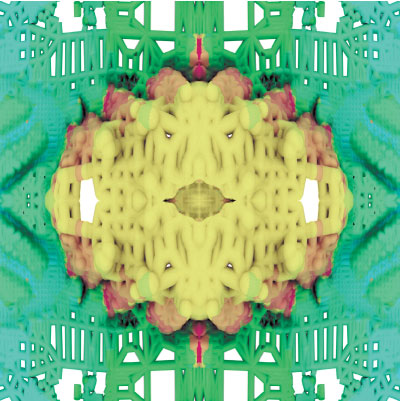
FAB.REcology by Neri Oxman, 2009 winner of The Earth Awards

The Earth Awards is an attempt to bring international public awareness to the necessity of sustainable design. An annual competition since 2007, the Earth Awards “came from a collective of creative thinkers who were designers, architects, scientists, writers, entrepreneurs”, says director Karena Albers. Collectively, the group was “in agreement that not only [are] good design and sustainable design synonymous, but also that … this movement of environmentalism was not moving ahead as quickly as we would have liked, and we believed it was because sustainable thinking wasn’t integrated into popular culture”.
The Earth Awards’ mission is to “find good design and then to connect the innovator with whatever that innovator needs to further his idea or her idea into the marketplace”, says Albers. Past winners have integrated biomimicry with building design, designed solar-powered LED lighting schemes, and created sustainable ways to farm ocean fish.
A particular strength of the Earth Awards lies in its selection committee. The Awards aim to bring in some of the most visible (and visionary) minds in the fields of art, architecture, design, environmentalism, activism and fashion. The eclectic group of judges ranges from Jane Goodall to Diane von Furstenberg to Paola Antonelli, the Senior Curator for Architecture and Design at MoMA.
(more…)
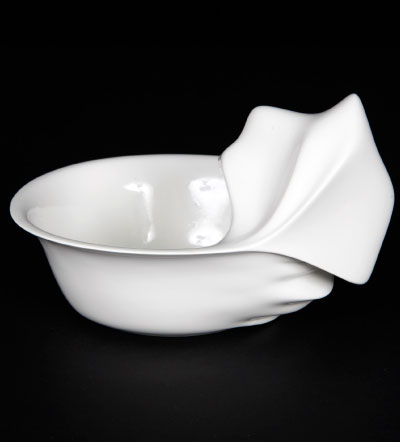
Photography and video courtesy of Geoffrey Mann

Geoffrey Mann of
Studio*Mrmann is an artist and designer who disintegrates the dividing line between art, craft, and design. His creations challenge our notions of the genres as he works to enlarge the gray area between them. Originally from and currently based in Edinburgh, UK, Mann received a postgraduate degree in Ceramics and Glass from the Royal College of Art, London after completing an undergraduate degree in 3D Design at Gray’s School of Art in Aberdeen. The integration of crafts, design, and multimedia demonstrated by Mann’s path as a student is also clear in his latest work,
Cross-fire — a unique project that seamlessly integrates a gorgeous work of animation with an unusual series of dishware and utensils.
Cross-fire animates a sound clip from American Beauty, the Oscar-winning film directed by Sam Mendes, in which the main character argues with his wife and daughter over the dinner table. In the clip, the voices of each character undulate through the plates, glasses, and utensils. As the emotions reach a crescendo, the waves of sound crash through the normally inanimate objects and deform “their once static existence into objects of unseen familiarity”, according to Mann’s description. Click through for the video.
(more…)
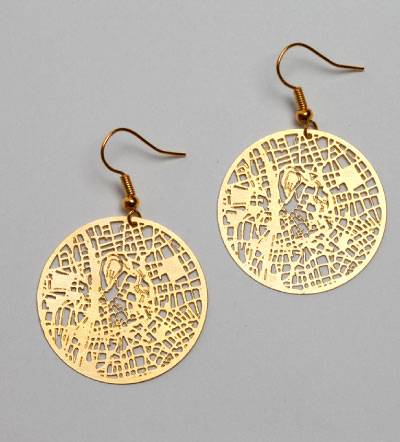

Physical places have an uncanny way of evoking nostalgia. Maybe it’s the street corner in New York where you first met your significant other or the club you went to practically every weekend that semester you studied in Berlin. It could be your childhood home, the campus of your alma mater or even that park in Copenhagen you spent one perfect day just lounging in—whatever the place or connection, our most visceral memories are inextricably linked to their locales.
Fluid Forms, an Austrian design firm, has come out with a design called Streets Earrings that allows anyone to adorn themselves with a satellite street map of any location in the world—a physical reminder of one’s best memory. In a process similar to developing photos, thin metal sheets are photo etched with satellite images of a location selected by the customer. The result is a delicately engraved satellite map, enclosed in a simple, dangling hoop.
Hannes Walter and Stephen Williams, co-founders of Fluid Forms, collaborated with New York-based urbanist and designer John Briscella to make the Streets designs. The series came after the firm’s initial line of custom products, which are all based on topographical maps of the Earth. “Realizing that our Earth concept often doesn’t work in large cities, which tend to be flat, we had been looking to something that would work well in cities for a while,” writes Williams vie e-mail. “Urbanism is becoming a trend, and since a lot of emotions are tied up to locations within cities, the streets concept became the perfect extension to the Earth concept.”
(more…)






 Facebook
Facebook Permalink
Permalink Digg
Digg Reddit
Reddit LinkedIn
LinkedIn StumbleUpon
StumbleUpon Tumblr
Tumblr













